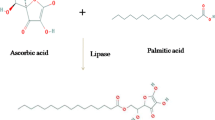Abstract
l-ascorbyl palmitate (ASP) is an oil-soluble derivative of ascorbic acid which is used extensively in food, cosmetics industry, and medical hygiene. Enzymatic synthesis of ascorbyl palmitate in tert-butyl alcohol was carried out using indigenously immobilized lipase preparation PyCal with ascorbic acid and palmitic acid as starting material. The developed batch process under optimized reaction conditions resulted in conversion of 90% with relatively shorter reaction time of 6 h. Continuous process in packed bed reactor gave conversion of 50% with space time yield of 15.46 g/L/h which was found to be higher than the reported literature on enzymatic synthesis of ascorbyl palmitate. The immobilized lipase used in the present work showed good reusability. Characterization of formed ascorbyl palmitate was carried out by FTIR, MS/MS, H1-NMR, and C13-NMR. The enzymatic process resulted in selective synthesis of 6-O-l-ascorbyl palmitate with purity of 98.6% and no side product formation. The use of underivatized starting materials, high space time yield of 15.46 g L−1 h−1, high recyclability of catalyst, and no by-product formation make the overall process highly efficient and clean in terms of energy consumption and waste generation, respectively. The optimized reaction parameters for ascorbyl palmitate synthesis in the present study can be used as a useful reference for industrial synthesis of fatty acid esters of ascorbic acid by enzymatic route.
















Similar content being viewed by others
References
Kaitaranta, K. J. (1992). Control of lipid oxidation in fish oil with various antioxidative compounds. Journal of the American Oil Chemists' Society, 69, 810–813.
Youchun, Y., Bornscheuer, U. T., & Schmid, R. D. (1999). Lipase-catalyzed synthesis of vitamin C fatty acid esters. Biotechnology Letters, 21, 1051–1054.
Liu, X. Y., Guo, F. L., Wu, L. M., Liu, Y. C., & Liu, Z. L. (1996). Remarkable enhancement of antioxidant activity of vitamin C in an artificial bilayer by making it liposoluble. ChemPhys Lipids, 83, 39–43.
Liu, Z. Q., Ma, L. P., & Liu, Z. L. (1996). Making vitamin C lipophilic enhances its protective effect against free radical induced peroxidation of low density lipoprotein. Chemistry and Physics of Lipids, 95, 49–57.
Humeau, C., Girardin, M., Coulon, M., & Miclo, A. (1995). Synthesis of 6-O-palmitoyl-L-ascorbic acid catalyzed by Candida antarctica lipase. Biotechnology Letters, 17, 1091–1094.
Humeau, C., Girardin, M., Rovel, B., & Miclo, A. (1998). Enzymatic synthesis of fatty acid ascorbyl esters. Journal of Molecular Catalysis B: Enzymatic, 5, 19–23.
Bradoo, S., Saxena, R. K., & Gupta, R. (1999). High yields of ascorbyl palmitate by thermostable lipase-mediated esterification. Journal of American Oil Chemist Society, 76, 1291–1295.
Lerin, L. A., Richetti, A., Dallago, R., Treiche, H., Mazutti, M. A., Oliveira, J. V., Antunes, O. A. C., Oestreicher, E. G., & de Oliveira, D. (2012). Enzymatic synthesis of ascorbyl palmitate in organic solvents: process optimization and kinetic evaluation. Food and Bioprocess Technology, 5, 1068–1076.
Lerin, L. A., Feiten, M. C., Richetti, A., Toniazzo, G., Treichel, H., Mazutti, M. A., Oliveira, J. V., Oestreicher, E. G., & de Oliveira, D. (2011). Enzymatic synthesis of ascorbyl palmitate in ultrasound-assisted system: process optimization and kinetic evaluation. Ultrasonics Sonochemistry, 18, 988–996.
Sun, W. J., Zhao, H. X., Cui, F. J., Li, Y. H., Yu, S., Zhou, Q., Qian, J. Y., & Dong, Y. (2013). D-isoascorbyl palmitate: lipase-catalyzed synthesis, structural characterization and process optimization using response surface methodology. Chemistry Central Journal, 7, 114–126.
Jiang, X. J., Hu, Y., Jiang, L., Zou, B., Song, P., & Huang, H. (2013). Optimization of enzymatic synthesis of L-ascorbyl palmitate by solvent engineering and statistical experimental designs. Biotechnology and Bioprocess Engineering, 18, 350–357.
Hsieh, H. J., Chen, J. W., Giridhar, R., & Wu, W. T. (2005). Synthesis of mixed esters of ascorbic acid using methyl esters of palm and soybean oils. Preparative Biochemistry & Biotechnology, 35(2), 113–118.
Hsieh, H. J., Nair, G. R., & Wu, W. T. (2006). Production of ascorbyl palmitate by surfactant-coated lipase in organic media. Journal of Agricultural and Food Chemistry, 54, 5777–5781.
Rich, J. O., Bedell, B. A., & Dordick, J. S. (1995). Controlling enzyme-catalyzed regioselectivity in sugar ester synthesis. Biotechnology and Bioengineering, 45, 426–434.
Yoo, I. S., Park, S. J., & Yoon, H. H. (2007). Enzymatic synthesis of sugar fatty acid esters. Journal of Industrial and Engineering Chemistry, 13(1), 1–6.
Ringborg, R. H., & Woodley, J. M. (2016). The application of reaction engineering to biocatalysis. Reaction Chemistry and Engineering, 1, 10–22.
Phuah, E. T., Tang, T. K., Lee, Y. Y., Choong, T. S. Y., Tan, C. P., & Lai, O. M. (2015). Review on the current state of diacylglycerol production using enzymatic approach. Food and Bioprocess Technology, 8, 1169–1186.
Funding Information
The authors are grateful to the financial support provided by Department of Biotechnology under the Ministry of Science and Technology, Government of India.
Author information
Authors and Affiliations
Corresponding author
Ethics declarations
Conflict of Interest
The authors declare that they have no conflicts of interest.
Rights and permissions
About this article
Cite this article
Yadav, M.G., Kavadia, M.R., Vadgama, R.N. et al. Production of 6-O-l-Ascorbyl Palmitate by Immobilized Candida antarctica Lipase B. Appl Biochem Biotechnol 184, 1168–1186 (2018). https://doi.org/10.1007/s12010-017-2610-5
Received:
Accepted:
Published:
Issue Date:
DOI: https://doi.org/10.1007/s12010-017-2610-5



